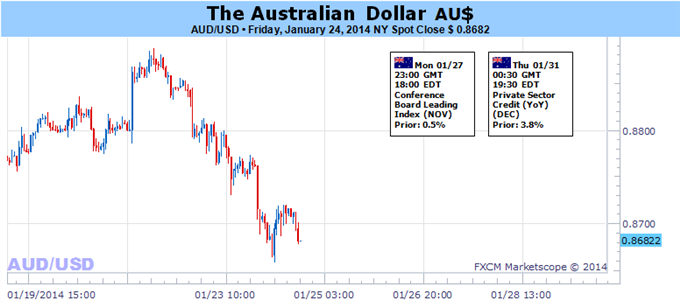Australian Dollar at a Crossroads as Focus Turns to FOMC

Fundamental Forecast for Australian Dollar: Neutral
Australian Dollar Sank to a 3.5 Year Low Amid Risk Aversion Last Week
Forward Outlook Clouded as the Spotlight Turns to the FOMC Outcome
Help Time Key Turning Points for the Australian Dollar with DailyFX SSI
The Australian Dollar continued to sink last week, dropping 1.1 percent against its US namesake to settle at the weakest level in three and a half years. The currency veered away from its relationship with US Treasury yields – a reflection of sensitivity to the Fed monetary policy outlook – to take cues from risk sentiment trends. Indeed, last week’s selloff tracked a sharp downward reversal in the MSCI World Stock Index while the rate on the benchmark US 10-year note fell to the lowest in two months (2.715 percent).
Another rotation in the driving catalysts behind Aussie price action may on tap in the week ahead as the spotlight turns to the FOMC monetary policy meeting. The sit-down will mark the first outing to be led by newly-minted Fed Chair Janet Yellen. Expectations call for another $10 billion cutback in aggregate QE, spread evenly between purchases of MBS and Treasury bondsecurities. While a mixed tone to US economic news-flow in recent weeks has introduced a degree of speculation about a pause in the “tapering” process, commentary from Fed officials has forcefully dismissed such concerns, suggesting stimulus reduction will proceed as advertised.
Confirmation of another $10 billion cutback would effectively reflect the FOMC policy status quo as established at December’s meeting. With that in mind, traders will be keen to dissect the text of the statement accompanying the announcement. On this front, the spotlight will be on any changes in the forward-guidance framework accompanying the QE cutback process. The US unemployment rate averaged 7.3 percent in 2013, a hair higher than the 7.0-7.1 percent range expected by the FOMC in December’s updated set of economic forecasts. Inflation expectations derived from bond yields (so-called “breakeven rates”) are pointing to price growth below 2 percent in the next 1-2 years, hinting the 2.5 percent bound set by the FOMC is not in danger.
On balance, this points to a lack of urgency in tinkering with any of the central bank’s key strategy components in the near term. Such an outcome may reignite interest in the Fed’s gradual shift away from the dovish extreme of the monetary policy spectrum, pushing yields higher and weighing on spread-sensitive currencies including the Aussie. The re-emergence of a positive relationship between the Australian unit and sentiment trends may make for an interesting transitional period however. Pro-taper developments have turned out risk-positive of late, seemingly reflecting traders’ growing confidence in the resilience of the US economy. If a confident FOMC is on-boarded as a sign of firming recovery and brightens the markets’ mood, AUD may yet find a near-term lifeline. -IS
DailyFX provides forex news and technical analysis on the trends that influence the global currency markets.
Learn forex trading with a free practice account and trading charts from FXCM.

